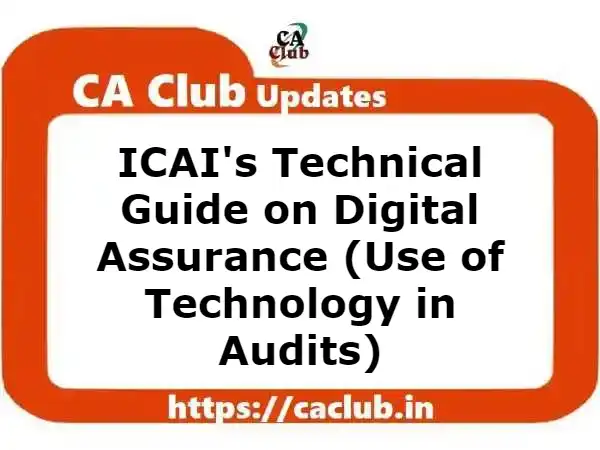The ICAI has released a “Technical Guide on Digital Assurance” to provide guidance to members on the use of technology in audits (January 2023 Edition).
The ICAI came to the conclusion that its members needed direction about the application of technology in auditing. The members are required to report or validate their understanding of a variety of material that is made available to them in an online format. It is important that the members be informed about such sources that are conveniently accessible through online methods and that they can utilise in the course of their audit operations. This would also aid in minimising the amount of time needed to complete the audit procedures successfully.
The Auditing and Assurance Standard Board (AASB) of the ICAI and the Digital Accounting and Assurance Board (DAAB) of the ICAI worked together to make this guide.
The ICAI’s Technical Guide on Digital Assurance primarily focuses on available sources of external audit evidence and how members can use it in their audit procedures. This Guide also emphasises the significance of the source from which the information is obtained in terms of reliability and relevance. Members are advised to consider the reliability and relevance of the source and information being used in audit, in addition to using the available source. This Guide also includes examples of available sources of external audit evidence and how to use them.
According to SAs, the auditor must collect enough acceptable audit evidence to establish reasonable conclusions to support their assessment. “Audit Evidence,” SA 500, outlines auditor requirements. Accounting records and other sources are used as audit evidence. Evidence from external audits is critical. Technology has increased the accessibility of old and new external sources of information to businesses and their auditors. More data is being provided by web data aggregators and social media sites. The auditor must assess the relevance and credibility of external information presented as audit evidence, regardless of whether it was used by the entity (auditee) in compiling the financial statements or collected by the auditor.
Given the entity’s (the auditee’s) ability to influence the external information source, judgement may be required to determine whether the external information is appropriate for a wide range of consumers. Whether the external person or organisation is a management expert or a source of information, a decision must be made. The nature and authority of the external information source; data independence; the competence and reputation of the source in relation to external information; the auditor’s previous experience with information reliability; the market acceptability of the data source; whether information has been reviewed or verified; alternate sources of information; and If the auditor is unable to gather sufficient appropriate audit evidence through alternative processes, the scope may be limited. During the audit, auditors may use external digital data.
The ICAI’s Technical Guide on Digital Assurance also provides a few examples of how to use external electronic or digital data in audits.
ICAI’s Technical Guide on Digital Assurance (Use of Technology in Audits) dt. 14-01-2023

Technology is changing data analysis and business. “Data Management” is the new buzzword, surpassing “Know Your Client” (KYC). Auditors can now analyse non-corporate data. Technology provides 100% sample population auditing. Technology can shorten audit timeframes by automating and real-time testing. Technology and AI are not new. Auditors have long used CAATS and other audit documentation tools. Everyone has cutting-edge tech. Tech-savvy audits are expected. Automating data extraction repositories and sampling has improved audits. Technology is audited digitally. Digital client technology and innovative auditing can increase auditor quality and efficiency (digital auditing). Audits must improve. New technologies allow data collection, automation, analysis, and threat identification. Auditing tools allow everyone to use technology. Technology knowledge and auditing problems are the opportunity. Drones and AI could have a significant impact in many situations. These technologies may alter audit scope (e.g., in using data analytics and machine learning to help identify fraud).